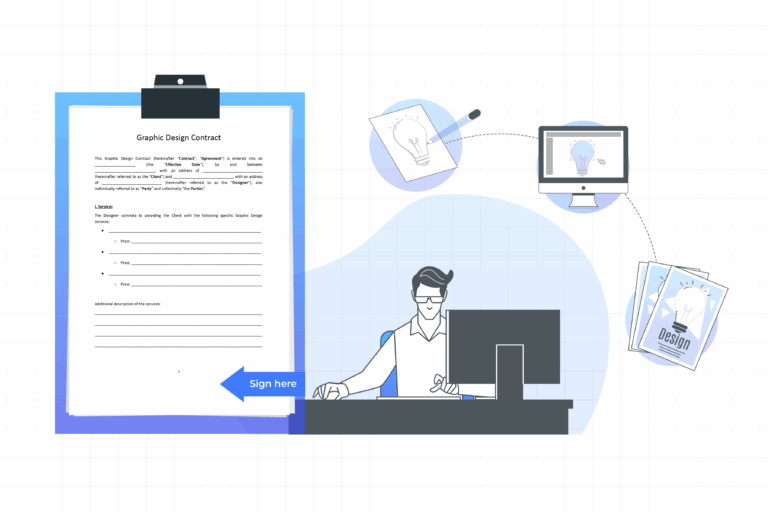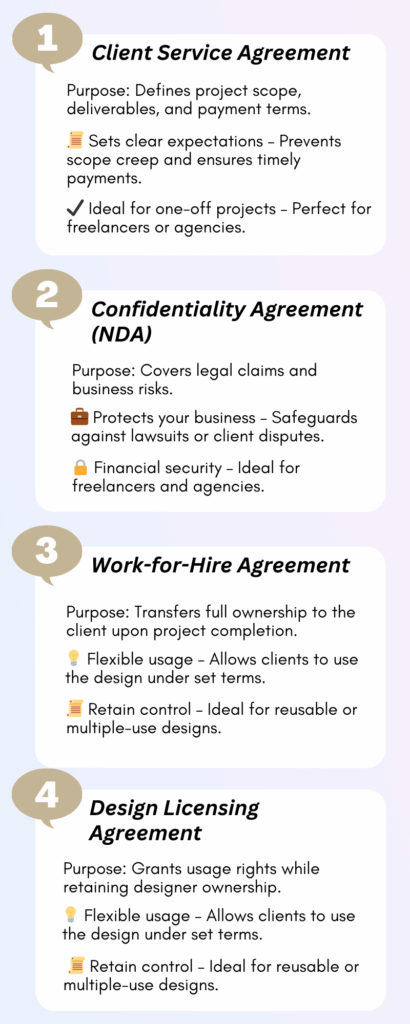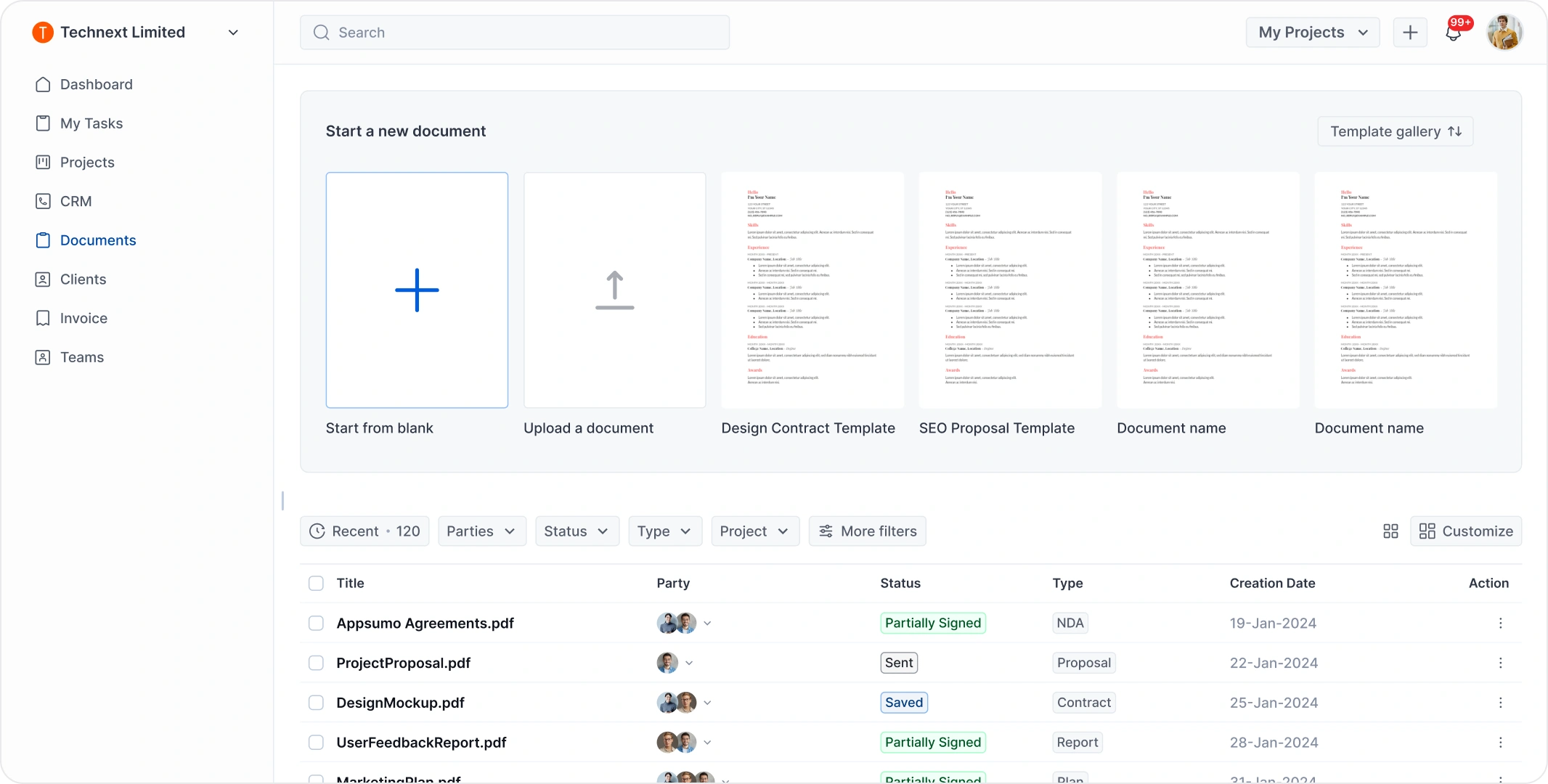
Freelance designers often face a tough challenge—clients who request endless redesigns or delay payments for work completed. It can feel like you’re working in circles, constantly adjusting designs without fair compensation. But this can easily be avoided with one simple solution: a graphic design contract.
The OneSuite Graphic Design Contract is the best way to set expectations, define the scope, and ensure you get paid on time. It protects your time and creativity while helping clients understand exactly what they’re getting. By establishing the terms upfront, you eliminate confusion and frustration.
In this article, you’ll discover:
- How a graphic design contract prevents scope creep and redesign fatigue
- Essential clauses to include for clarity and protection
- How to use a free template to make your contract work for your specific services
This contract is a must-have for freelancers and agencies alike, giving you peace of mind and ensuring your client projects run smoothly from start to finish.
Free Graphic Design Contract Template
Before we dive in—if you’re here for the contract, go ahead and grab it now:
How to Customize This Graphic Design Contract Template (The Easy Way)
I get it—contracts can feel overwhelming, especially when you see all the legal terms packed into multiple pages. I have felt that same hesitation before. But here’s the truth: having a solid agreement protects you and your client and customising it is easier than it looks.
This template is colour-coded to guide you through every step:
- 🟨 Yellow fields = Designer part to fill in
- 🟩 Green fields = Client’s part to fill in
Just follow these simple steps, and you’ll have a professional contract ready to go in no time:
Fill in the Colour
Start with all the highlighted areas—replace every bracket with accurate information.
Here’s what you’ll need to update:
- Client and designer names, addresses, phone numbers, and emails
- Project name and starting date
- Scope of work and timeline
- Agreed payment terms (hourly, fixed, retainer—whatever works best)
- Revision limits, cancellation terms, and other custom conditions
- Signature, printed name, and date (for both parties)
- Once filled, remove the highlight colours for a clean final version.
With all the blanks filled, the final step is signing off.
No need to print anything. Just use a digital tool like OneSuite to send and collect signatures. It’s quick, professional and keeps things moving.
Most platforms offer a free trial—perfect if you’re just starting.
Want a quick demo?
👇 Watch how to send and sign your agreement in less than 3 minutes:
⚡️ See Also: How to Write a Contract Agreement: A Simple Step-by-Step Guide
Types of Graphic Design Contracts: Which One Is Right for You?
Whether you’re a freelance designer or running a design agency, having the right type of contract is crucial for protecting your work and managing client expectations.
Each contract type serves a different purpose, whether it’s a one-time project, ongoing work or protecting intellectual property.
Here’s a breakdown of the key types of graphic design contracts you’ll encounter and how they can benefit both you and your clients.

See also: Download a free graphics design proposal template.
What to Include in Your Graphic Design Contract
A graphic design contract isn’t just a formality; it’s your safety net. It ensures your work is protected, payments are made on time, and both you and your client understand the project’s expectations.
Let’s dive into the top 10 must-have clauses in your design contract to ensure a smooth, professional collaboration.
1. Deliverables: Clearly Define What You’ll Provide
This section outlines exactly what the client will receive upon completion of the project. It clarifies the work that will be delivered and ensures that both parties are aligned on expectations.
- A list of all deliverables (e.g., logo design, business card layouts, website design).
- File formats for each deliverable (e.g., AI, PNG, JPG).
- Any additional items such as branding guidelines, fonts, or mockups.
Be specific about the quantity and type of designs the client will receive (e.g., “3 logo concepts, 2 rounds of revisions”). Avoid vague terms like “design work” and ensure there’s clarity on what’s included in the price.
2. Project Timeline and Process: Set Clear Milestones
The timeline section outlines the entire process of the project, from start to finish. This will ensure there is no confusion regarding deadlines and responsibilities.
- Project start date and expected end date.
- Key milestones (e.g., “mood board approval by Week 2” or “draft designs presented on Day 10”).
- Client responsibilities at each stage (e.g., providing feedback within 3 days of receiving design drafts).
Be explicit with delivery dates and what happens if the client delays (e.g., “If client delays feedback by more than 5 days, the timeline will be adjusted”).
3. Payment Terms: Be Transparent About Costs
Payment terms ensure you’re compensated fairly and promptly for your work. Clearly outline how much you’ll be paid, when, and any late fees that may apply.
- Total cost of the project.
- Payment schedule (e.g., 50% upfront, 50% upon completion).
- Late payment fees (e.g., “A 5% fee will be added if payment is not made within 7 days of the due date”).
- Non-refundable deposit: Protects you if the client backs out.
Consider installment payments for larger projects. A non-refundable deposit should be mandatory to ensure the client is serious about the project.
4. Scope Creep and Alterations: Handle Changes Proactively
Scope creep occurs when clients ask for additional work beyond what was initially agreed upon. This clause prevents this from happening by specifying how alterations to the original agreement will be handled.
- Scope of work (the services included and excluded from the project).
- Handling changes: If the client requests more work, how will that be priced (e.g., hourly rate or additional flat fees)?
Incorporate a clause that specifies additional work will be billed at an hourly rate or new agreed-upon rate for each new request.
5. Ownership and Copyright: Protect Your Work
This clause outlines who owns the work once the project is completed and paid for. It ensures that the client doesn’t assume ownership over your intellectual property unless explicitly stated.
- Copyright ownership: Define whether you retain the rights to the work or transfer them to the client upon payment.
- Usage rights: If you’re retaining ownership, specify how the client can use your work (e.g., “Client may use the logo only for digital marketing purposes”).
Always clarify whether you’re granting a license to use or transferring ownership of the design. Retain ownership if you plan on using the designs in your portfolio.
6. Cancellation and Kill Fees: Protect Yourself Against Sudden Termination
The cancellation clause ensures that you’re compensated for work completed if the client cancels the project halfway. A kill fee is a set percentage you’ll charge if the client decides to cancel after work has started.
- Conditions for cancellation (e.g., “Either party can terminate the project with 10 days’ written notice”).
- Kill fee: Define how much the client owes if the project is canceled early (e.g., “Client will pay for all work completed up to the point of cancellation, plus a 20% kill fee”).
Specify how the client’s deposit will be handled in case of cancellation. Also, include any prepaid third-party expenses (e.g., printing costs) as part of the kill fee.
7. Out-of-Pocket Expenses (OOP): Be Clear on Extra Costs
Out-of-pocket expenses cover any additional costs that arise outside of the normal project scope, such as travel, printing, or third-party services.
- List of reimbursable expenses (e.g., travel, accommodation, or materials).
- Who is responsible for paying these costs (client or you).
Specify that all out-of-pocket expenses will be pre-approved by the client before incurring them, so there are no surprises at the end of the project.
8. Confidentiality & NDA: Protect Sensitive Information
This clause ensures that any proprietary or sensitive information shared between you and the client remains confidential.
- Non-disclosure agreement (NDA): Specify that both parties agree to keep any sensitive business information shared during the project private.
Include a time limit for confidentiality (e.g., “This agreement remains in effect for 3 years after the completion of the project”).
9. Revisions and Approval Process: Define Limits on Changes
This clause sets clear guidelines on how many revisions are included in the project and what happens if additional revisions are requested.
- Number of revisions included in the initial price (e.g., 2 rounds of revisions).
- Extra charges for additional revisions beyond the included rounds.
Be specific about what constitutes a revision (e.g., minor tweaks versus a new design concept). This prevents clients from expecting unlimited changes without additional charges.
10. Termination and Dispute Resolution: Plan for Conflict
This clause defines how the contract can be terminated, either by you or the client, and how any disputes will be resolved (e.g., mediation or legal proceedings).
- Conditions for contract termination (e.g., breach of terms, mutual agreement).
- Dispute resolution process: Mediation or arbitration clauses, and the location for resolving disputes.
Make sure to specify the jurisdiction where disputes will be handled (e.g., “In the event of a dispute, the contract will be governed by the laws of [state/country]”).
⚡️See also: Free Web Design Contract Template (Download First!)
Main Graphic Design Contract Mistakes Designers Must Avoid
As a graphic designer, your contract is essential for protecting your work, setting clear expectations, and ensuring that both you and your client are on the same page.
However, many designers make critical mistakes that can lead to project delays, payment issues, and legal problems.
Here are the most common contract mistakes you should avoid to keep your business running smoothly.
- Vague Terms and Undefined Deliverables: Not specifying exactly what’s included in the project can lead to confusion and scope creep. Be clear about the design services, the number of revisions, and the deliverables.
- Failure to Set Boundaries for Revisions: Without a clear number of revisions, clients might expect unlimited changes without additional costs. Set a limit on revisions and specify fees for extra changes.
- Omitting Payment Terms: Not outlining when and how you’ll be paid can lead to delayed payments or disputes. Always define the total cost, payment schedule, and penalties for late payments.
- Ignoring Intellectual Property and Ownership Rights: Failing to clarify ownership of the design work can result in the client using your work without permission. Specify who owns the design and its usage rights.
- Using a Generic Contract Template: A one-size-fits-all contract can miss important details or clauses specific to a project. Always customize your contract for each client and project to reflect unique needs and circumstances.
- Not Addressing Project Cancellation or Kill Fees: If a project is canceled early, not having clear terms for compensation can leave you unpaid for work done. Include a kill fee to ensure you’re compensated for any time and resources invested.
- Lack of Clear Client Responsibilities: Not specifying the client’s role in providing feedback, materials, or meeting deadlines can cause delays. Define what you expect from your client at every stage of the project.
- Failure to Address Confidentiality: If your client shares sensitive information, it’s essential to protect it. Include confidentiality clauses to ensure you are legally bound to keep their business details private.
- No Dispute Resolution Clause: Without a defined process for handling conflicts, you may find yourself stuck in costly legal disputes. Specify mediation or arbitration as the first step in case of disagreements.
- Not Getting Signatures or Dates: A contract without signatures is not legally binding. Always ensure both you and the client sign and date the contract before starting work.
Risks of Not Using a Graphic Design Contract
Skipping a contract might seem harmless—until something goes wrong. Without clear terms, you’re exposed to confusion, scope creep, and payment issues.
Common Risks:
- Scope Creep: No defined boundaries = extra work with no extra pay.
- Unpaid Work: No payment terms? You’re at risk of delays—or no payment at all.
- IP Conflicts: Without ownership clauses, your designs can be misused or claimed.
- Legal Trouble: If a dispute arises, you have no written proof to back you up.
- Misunderstandings: Verbal agreements often lead to confusion and unmet expectations.
No contract? Too many risks.
Protect your work, your time and your peace of mind—before the project even begins.
Read Also: Download our free logo design contract template to secure your work, set clear terms, and ensure smooth collaboration with every client.
Create a Free Graphic Design Contract with Onesuite
Creating a free graphic design contract in OneSuite is quick and hassle-free. Start by clearly outlining all services, deliverables and payment terms. You can either upload your finalized contract as a Docs file or use OneSuite’s editor to create it directly within the platform.
Here’s how to get started:
Write Your Contract – Use OneSuite’s editor to create a clear contract outlining your services, deliverables, and payment terms.
- Upload to OneSuite – Go to the Documents section and upload your contract.
- Add Signature Fields – Add fields for both you and your client to sign and date the contract.
- Link to Client Profile – Attach the contract to the client’s profile for easy tracking.
- Send for Signature – Send the contract to your client via a secure link for signing.
- Lock Contract Automatically – Once signed, the contract will be locked automatically, providing a legally verified document.
- Save as a Template – Save the contract as a reusable template for future projects.
Ready to streamline your contract process? Create your free graphic design contract today with OneSuite! Save time, eliminate paperwork hassles, and ensure smooth client projects.
Frequently Asked Questions (FAQs)
What is a Freelance Graphic Design Contract?
A freelance graphic design contract is a legal agreement that defines the project’s scope, deliverables, payment terms and other key conditions. It ensures both the designer and client are aligned on expectations, timelines and responsibilities.
Why use a free Graphic Design Contract Template?
A free graphic design contract template saves time by offering a ready-made structure with key clauses, such as payment terms and scope of work. It’s easy to customize for each project, ensuring both you and your client are aligned on expectations from the start.
Can I use a free Graphic Design Contract for different projects?
Yes, you can! A free graphic design contract template is highly adaptable for various projects, whether you’re working on logos, websites or marketing materials. It covers essential aspects like timelines and ownership, ensuring smooth and clear communication.
When should I show the Graphic Design Contract to my Client?
Present the contract before starting any work. It sets clear expectations around payment, timelines and scope, protecting both you and your client. Doing so ensures a professional and smooth collaboration, reducing the risk of misunderstandings.
Find a Better Way to Grow
OneSuite streamlines projects, clients, and payments in one place, making growth hassle-free.

